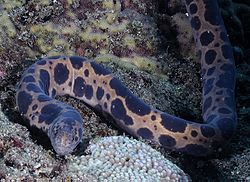| Scuticaria | |
|---|---|
| Scientific classification | |
| Kingdom: | Animalia |
| Phylum: | Chordata |
| Class: | Actinopterygii |
| Order: | Anguilliformes |
| Family: | Muraenidae |
| Subfamily: | Uropterygiinae |
| Genus: | Scuticaria D.S. Jordan and Snyder, 1901 |
| Type species | |
| Ichthyophis tigrinus Lesson, 1828 | |
| Species | |
See text. | |

Scuticaria is a genus of moray eel in the family Muraenidae.